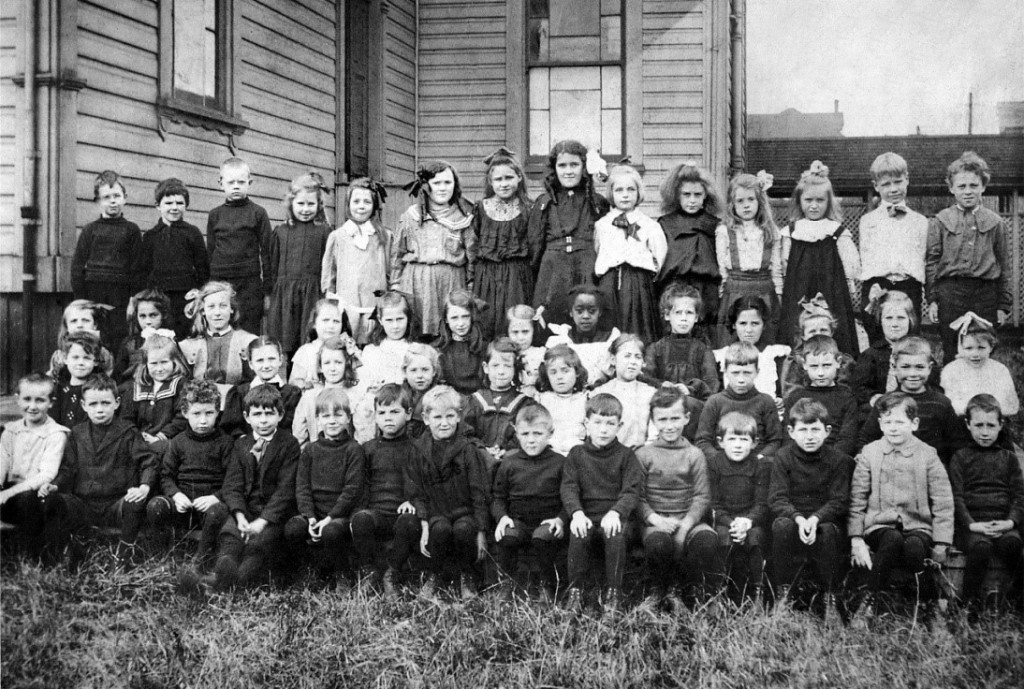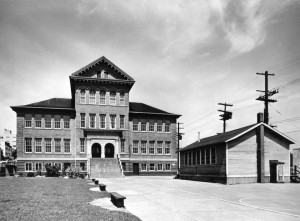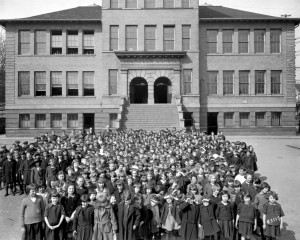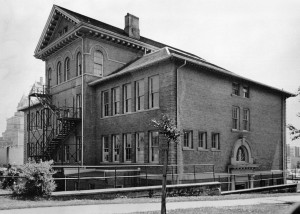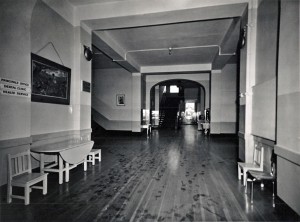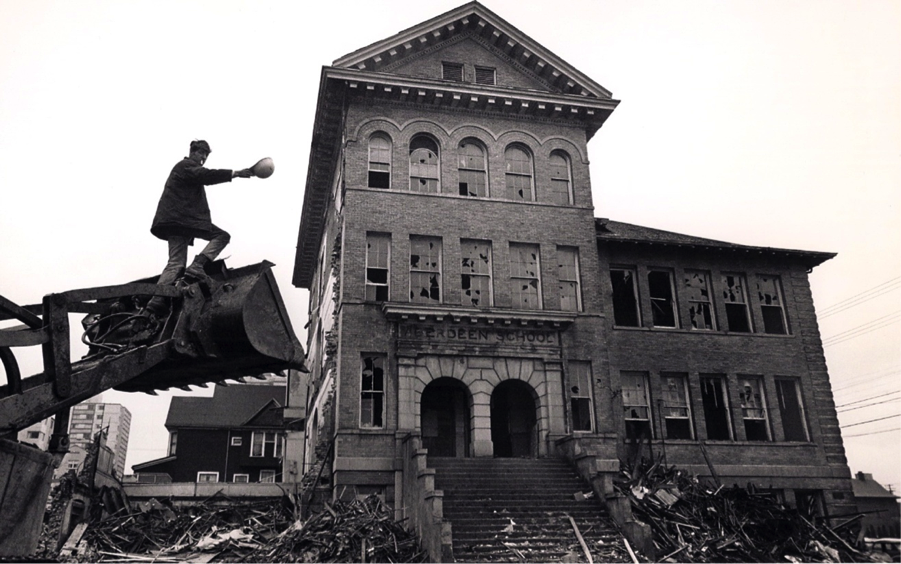Dawson Annex School
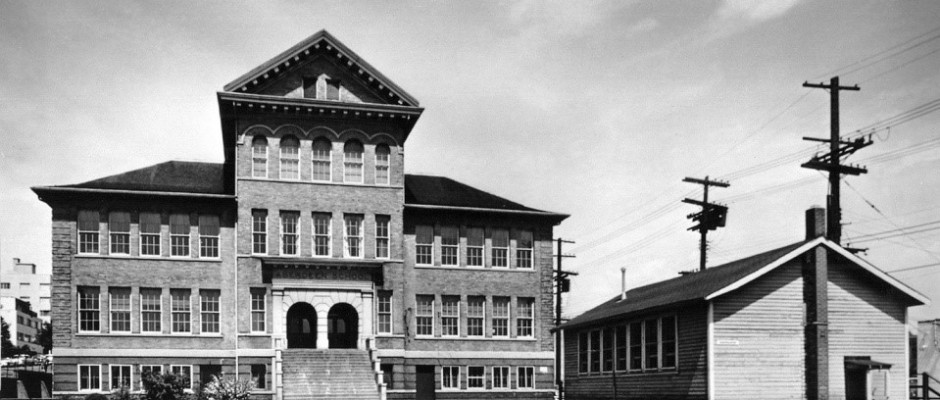 Dawson Annex
Dawson Annex
By Greg Wasko
Back in the day if you were growing up in the west end of Vancouver you were either a Roberts kid or a Dawson kid depending on which elementary school you attended, Lord Roberts or Sir William Dawson. I was a Dawson kid and started kindergarten at Dawson Annex School located at the corner of Burrard and Barclay in September of 1957. A school had occupied that site since 1888 when one of the earliest ones in the young town of Vancouver was built—West School, a small four room wooden structure so named to differentiate it from two schools already in existence: East School and Central School
I can imagine sitting in one of the classrooms when another class got out before you with the accompanying cacophony of footsteps running across the wooden floorboards in their rush to get out and waiting anxiously for my chance to also be free. The building was woefully inadequate for the rapidly growing city and a larger brick school was built a block away at Burrard and Nelson and opened in 1892, at first called West End School, then becoming Sir William Dawson Annex and later King George High School.
Meanwhile the small wooden building at Burrard and Barclay served as a kindergarten until it was demolished in 1907 and a grander structure was erected in 1908 to serve the primary grades called Aberdeen School after the Governor – General of Canada, The Earl of Aberdeen. The school operated until 1942 when the name was changed to Sir William Dawson School Annex or just plain Dawson Annex.
The 1940s saw the attendance of its most illustrious alumnus – guitarist extraordinaire Jimi Hendrix. Jimi was born November 27, 1942 in Seattle, Washington shortly after his parents moved there from Vancouver where his father Al was born in 1919. Jimi travelled back and forth between the two cities with his family quite a bit and in about 1949 he stayed with his grandmother Nora Hendrix at 827 East Georgia Street and attended grade 1 at Dawson Annex. It was a long distance to the school so he probably took the bus or streetcar since the fare was only 5 cents. On September 7 1968 The Jimi Hendrix Experience played at the Pacific Coliseum in Vancouver and that day he was interviewed by Terry David Mulligan where Jimi talked about Dawson Annex.
Aberdeen School, later called Dawson Annex (next 4 photos. Click for full size.)
- Dawson Annex
- Dawson Annex
- Dawson Annex
- Dawson Annex
During the 1950s the classes became overcrowded as the wave of children from the baby boom hit. By this time the school was starting to show its age and was closed in June of 1962, the students being absorbed into Dawson School at Burrard and Helmcken. Dawson Annex sat vacant for several years and the school grounds were used as a parking lot for the B.C. Hydro building. The school was demolished on April 1, 1969 and in its place the IGA Marketplace was built.
I started kindergarten at Dawson Annex on September 3, 1957. My mom walked me there the first day and after that I was on my own and wouldn’t have wanted it any other way. Our house was about half a block up the alley from the school at 1118 Haro St. so I would take the shortest route down the back lane. Mrs. Robson, the grade one teacher, saw me come onto the school grounds from the alley driveway entrance and told me not to use the alley for coming to school. I pointed out that I lived just a short way up the lane to no avail; she said I had to take Barclay Street and then use the proper entrance on Burrard. I felt compelled to follow her instructions even though I didn’t agree with her since I always roamed around the back allies. Upon reflection in later years I could see she was right because I would’ve had to come to school through the driveway where the staff parked their cars and the last thing they needed was a 5 year old appearing on the driveway from a blind corner.
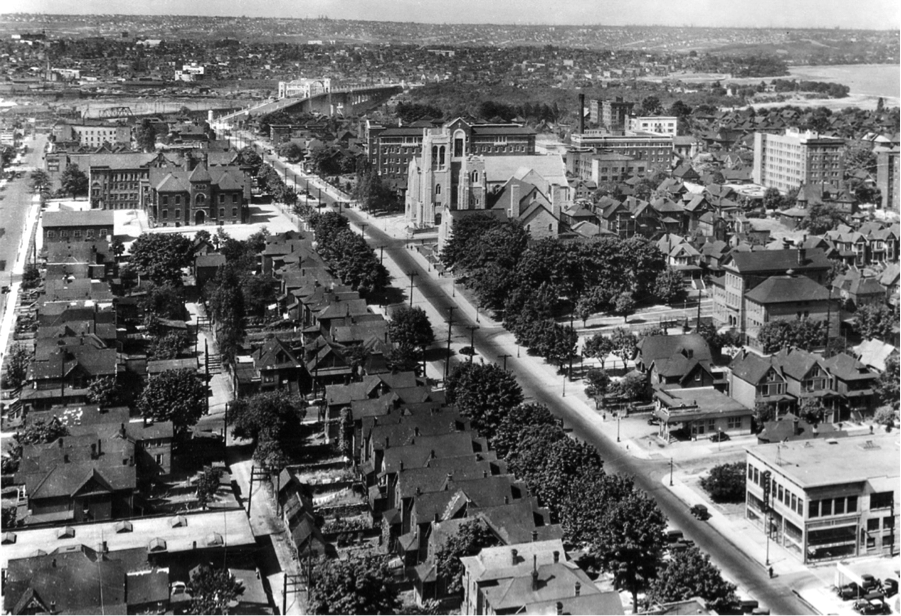
Upper left: King George High School; Dawson Elementary School behind. Lower right: Aberdeen School, later called Dawson Annex. Click for full view.
The kindergarten class was located in a small hut beside the main building. The school ground was half paved and half covered by a lush grass field bordered by bushes and shrubs. At the building end of this field was a flagpole and a kidney shaped wading pool that was disused. Monday and Wednesday were the boy’s days on the grass, Tuesday and Thursday were the girl’s days on the grass and Friday was everybody’s day on the grass.
I started in the morning kindergarten which suited me just fine since I liked getting up early and kindergarten would be over by lunch leaving the rest of the day free. The teacher was Mrs. Josephine Hicks a young woman with endless patience who never raised her voice to the class. Ross Laliberte would always address her as “Hey” and she would always answer “Don’t call me ‘hey’, the horse will come and eat me. Call me Mrs. Hicks.” Eventually he learned to call her “Hicks”.
Two brothers in my class, John and Stuart Milne, lived in Stanley Park at one of the service cabins, the one at Brockton Oval I think. Stuart was born with a hole in his heart and I remember seeing his picture in the Vancouver Sun newspaper after he had successful surgery to repair the defect. During school the day would be spent drawing and colouring, finger painting, cutting and pasting, playing with plasticine and other activities. Quite often certain kids would eat the paste and I couldn’t figure out why.
Half way through the morning we got served a cookie and milk and sometimes Elli Dobrowlsky would give me her cookie. Years later she told me she considered me her first boyfriend. At the end of the day Mrs. Hicks would show all our drawings to the class and ask the person who drew it to explain what it was. I remember that Peter Neilson always drew “injuns” (Indians).
After Christmas in January 1958 I was switched to afternoon kindergarten which made the day seem to drag out longer. The first difference I noticed was when they assigned us the long, brown sackcloth robes I had seen hanging on a rod but were never used during morning kindergarten. After putting them on we dragged out mats and were supposed to take a nap. I thought they were kidding because I never napped during the day and found this to be torture, but was surprised to see classmates actually sleeping.
Many of our activities or when we went out required us to get in pairs and hold hands. Myself and Joanne Taylor would always make a beeline toward each other and I guess she was sort of my first girlfriend (sorry Elli). In June I was promoted to grade one which meant leaving the kindergarten hut and moving on to the school building and real work instead of fun and games. During the summer while walking past the school on Barclay I saw that the wading pool was filled and Georgina Spilos was in her bathing suit frolicking in the water while two adults were reclining on the grass beside her. This was the only time I saw the wading pool in use and wondered how she managed to pull that off.
In September 1958 I started grade one and learned that there was a whole new set of rules. At the beginning of the day a student would ring the large silvery hand bell at the top of the stairs in front of the school entrance and all the kids would run into their basement, the girls on the Barclay side and the boys on the back alley side. Once there we would marshal into lines depending on whose class we were in and after getting the okay to proceed by the teacher in charge that day would walk up the stairs to our classroom and wait to be let in by our teacher. It was all very orderly. At 10:30 we would be let out for a 15 minute recess then repeat the procedure. The same at lunch.
On rainy days we spent our time before class playing in the basement which had posted on the wall a sign that read “Please do not run”. If you were caught running by a teacher the consequences were dire – you had to sit on the bench around the basement until the bell rang.
At recess and lunchtime on nice days the schoolyard would be a beehive of activity. The girls usually skipped rope or played hopscotch on the diagrams painted on the pavement. The boys often played tag, cops and robbers, cowboys and Indians and other games and the method of organization was unique. A few guys would get together and decide what they wanted to do then put their arms around each other’s shoulders and march around the grounds shouting “Who wants to play? Who wants to play?” Other kids would approach them, find out the game and if they wanted to participate would join the chorus line. When there was enough people they would commence playing. If the game wasn’t very popular only two or three people would march around until eventually giving up but if the game was really popular you could see chorus lines of a dozen and more.
Ringing the bell to signal the end of playtime was a coveted duty and had to be arranged beforehand with the janitor. If you were chosen you would wait on hand until he gave you the go ahead then run up the stairs to the entrance hallway and grab hold of the bell that sat on a small table on the left side near the entrance. Walking outside to the top of the stairs was exciting because you could see the grounds covered with kids and when you started ringing the bell there would be a mad scramble towards the basements. You could also be chosen to ring the second bell 5 minutes later but it was anticlimactic because by that time the grounds were empty and without an audience there just ain’t no show.
There was a lunchroom in the basement on the boy’s side but most of the time I preferred to go home to eat. The highlight of the year was sports day in June when races of all kinds were held on the grass field. Besides the sprints there was the sack race, the wheelbarrow race, the skipping race, the potato race, the dress-up race and others. All of the teachers and some parents were involved with officiating and awarding of ribbons. Shortly after this the school year was finished with report cards handed out signifying your promotion to the next grade the following September. This was the real highlight of the year, the start of the whole summer off.
There were two grade one classes taught by Mrs. Robson and my teacher Mrs. E. Sorenson, an older Scandinavian lady with salt and pepper hair pulled back tightly in a bun. She had obviously been doing this a long time and was competent and patient, rarely, if ever, raising her voice. Her classes were fun and I enjoyed the work. My grade two teacher was Miss C. J. Kerr who also served as the school principal. She was fairly young and a bit of a disciplinarian who had no trouble raising her voice when she wanted to. Though I didn’t like her class as much I got much better marks.
In the afternoons we switched to a different classroom run by Mrs. Lunn, an older and gentler teacher. When I passed grade two I looked forward to moving to the big school, Dawson Elementary on Burrard at Helmcken, and thought that I’d seen the last of Dawson Annex. This was not to be the case.
When I started grade three at Dawson the class was so overcrowded that not only were the seats filled but so was most of the standing room around the perimeter. This was clearly an unmanageable situation and early in September ten of us were shipped back to Dawson Annex where we were put in a split class with grade twos under Miss Kerr. I found having to resume lining up in the basement to go to class again to be humiliating. This lasted about two months then Dawson School got the situation sorted out and we were transferred back there into Mrs. Smith’s class which held in excess of 40 students.
At the end of the following year, in 1962, Dawson Annex closed its doors. I enjoyed my time there, the homey feeling and the lush grass field. I like that I went to the same school as Jimi Hendrix and that he was a Dawson kid.

